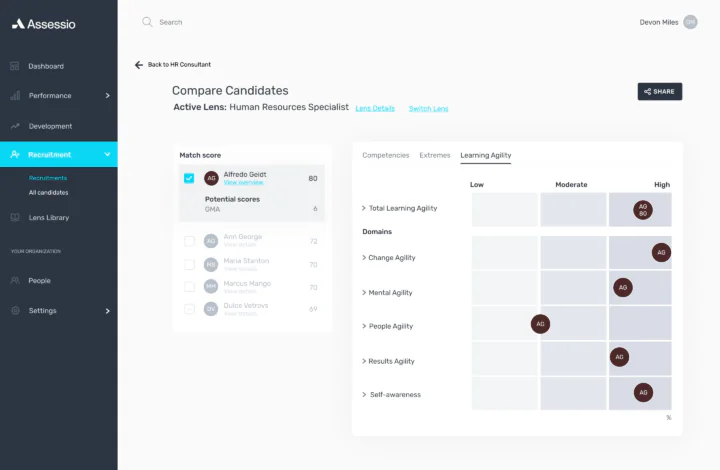Assessio AI er her
Learning Agility
Learning agility er evnen til hurtigt og fleksibelt at udvikle ny adfærd baseret på nye erfaringer og derefter anvende denne adfærd på en vellykket måde.

Om Learning Agility
Når du kender dine kandidaters og medarbejderes learning agility , får du en klar vejledning i, hvordan du skal navigere i en virkelighed i konstant forandring. Når man er usikker på, hvilke færdigheder der bliver brug for i fremtiden, bliver det vigtigere at kende den enkeltes potentiale for at lære nye ting. Med Learning Agility kan organisationer identificere, hvem der har sværest ved at håndtere forandringer, hvem der har brug for mere stimulering, og hvor der er behov for en indsats for at reducere personaleomsætningen og skabe forudsætningerne for succes.
Hvad gør os anderledes end andre?
Datadrevet
Dataindsamling til at support og vejlede beslutninger. Indsaml og genbrug data for at finde din bedste kandidat.
Forskningsbaseret
Evidensbaserede metoder og løsninger baseret på den nyeste forskning inden for personlighedsvidenskab og arbejdspsykologi.
Enkel
En brugervenlig platform, der forenkler komplicerede processer og beslutninger.
Omfattende
En omfattende vurderingsplatform, der giver support til rekruttering og udvikling af medarbejdere, ledere og organisationer.
"Når forandringer er en del af vores hverdag, stiller det nye krav til både ledere og medarbejdere. Din virksomheds konkurrenceevne er baseret på kontinuerlig læring og evnen til at tilpasse sig hurtigt. Learning Agility måler evnen til hurtigt at udvikle og anvende ny effektiv adfærd ud fra tidligere erfaringer."
Hvorfor er der brug for Learning Agility ?
Jobroller og funktioner i en organisation udvikler sig løbende, da behovet for arbejdskraft konstant ændrer sig. Det kan betyde ændrede arbejdsmetoder, som kræver et mindset for at være fleksibel, for at kunne lære nye færdigheder og for at kunne anvende dem på en effektiv måde. Learning agility giver dig mulighed for at identificere dine medarbejderes styrker og udfordringer, så du kan identificere, hvilke indsatser der er nødvendige, så du og din organisation er godt rustet til fremtiden.

Learning agility - en indikation af potentiale
Learning agility er evnen og viljen til at være nysgerrig, lære af sine erfaringer og anvende ny viden i forskellige situationer. For eksempel at udnytte muligheden for at lære nye ting, udvikle nye færdigheder, være i stand til hurtigt at ændre retning og tilpasse sig nye situationer, når det er nødvendigt.
Personer med høj learning agility opsøger situationer og miljøer, hvor de kan vokse, de har drivkraften til at tilegne sig nye færdigheder og kan håndtere udfordringer på en succesfuld måde. Indsigten i den enkeltes learning agility er baseret på resultaterne fra assessmenttesten Match-V og personlighedstesten MAP. Dette resulterer i en femdimensionel indsigt i learning agility samt en sammenligning af ens learning agility.
5 dimensioner: Sådan måler du Learning Agility
For at måle en persons learning agility ser vi på fem forskellige komponenter:
- Mental smidighed - interesse for at analysere og behandle information på forskellige måder
- Forandringsvillighed - i hvor høj grad en person sætter pris på forandring og på at gøre tingene på nye måder
- Menneskelig smidighed - evne til at lytte og lære af andre, villighed til at se andres perspektiv
- Resultatorientering - evnen til at se vanskelige opgaver som en udfordring og levere resultater på trods af svære omstændigheder
- Selvbevidsthed - bevidsthed om styrker og svagheder Selvbevidsthed er den mest centrale del af en persons learning agility. Jo større selvbevidsthed - jo større er evnen til at forandre og udvikle sig. En høj grad af selvindsigt har også en positiv indvirkning på de andre fire dimensioner og øger dem.
